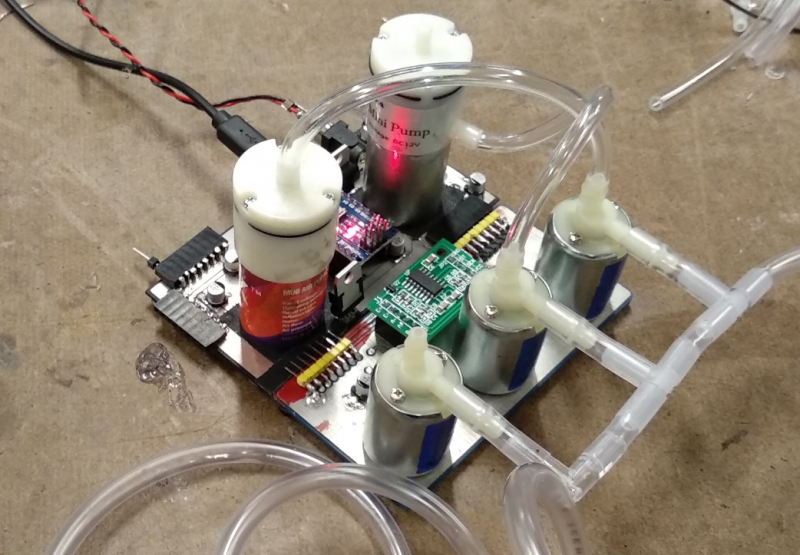[Amitabh] was frustrated by the lack of options for controlling air pressure in soft robotics. The most promising initiative, Pneuduino, seemed to be this close to a Shenzhen production run, but the creators have gone radio silent. Faced with only expensive alternatives, he decided to take one for Team Hacker and created Programmable Air, a modular system for inflatable and vacuum-based robotics.
The idea is to build the cheapest, most hacker-friendly system he can by evaluating and experimenting with all sorts of off-the-shelf pumps, sensors, and valves. From the looks of it, he’s pretty much got it dialed in. Programmable Air is based around $9 medical-grade booster pumps that are as good at making vacuums as they are at providing pressurization. The main board has two pumps, and it looks like one is set to vacuum and the other to spew air. There’s an Arduino Nano to drive them, and a momentary to control the air flow.
Programmable Air can support up to 12 valves through daughter boards that connect via right-angle header. In the future, [Amitabh] may swap these out for magnetic connections or something else that can withstand repeated use.
Blow past the break to watch Programmable Air do pick and place, control a soft gripper, and inflate a balloon. The balloon’s pressurization behavior has made [Amitabh] reconsider adding a flow meter, but so far he hasn’t found a reasonable cost per unit. Can you recommend a small flow meter that won’t break the bank? Let us know in the comments.


















Adafruit has a flow meter for about $10, or so I learned from some web board called Harkadry, no, no, HACKADAY, that’s it!
https://hackaday.com/tag/adafruit-flow-meter/
A medical grade pump for $9? I find that hard to believe.
It’s not medical grade of course. It is “for medical” :)
“DC 12V micro air pump Electric pumps mini vacuum pump pumping Booster For Medical”
https://www.amazon.com/gp/product/B01MR3JZZF/?smid=A3BG62S1F23IH5
Be sure to buy 3. I treat them as consumables, bit like toner ;)
Made a similar porject. I added two air tanks, one for pressure below ambient and one for above. The pumps are just to slow without it for SMD work.
These small air pumps are used in automatic sphygmomanometers (blood pressure meters), it doesn’t need to be some super high quality thing, you can buy a whole automatic meter from the usual places for not much more.
“Medical” is a loophole for use in states and countries that having an adult “doll” or toy with realistic features is banned.
For flow sensing, a two port differential pressure sensor and a choke can get very accurate results once it’s calibrated, at the expense of reduced total airflow.
Why do you need solenoid valves in series with the pumps? These are diaphragm pumps with internal check valves. So it should be sufficient to control the pressure by activating a pump or not.
Or you use only one pump and two 3-way solenoid valves, one on the pressure port and one on the suction port of the pump. Each of them either connects one pump port to the manifold or to an open vent .
Could current sensing on the pumps provide you with enough data to know how much resistance they were seeing? Might be a super cheap way to estimate when a balloon was full or empty. It wouldn’t be perfectly precise, but might be able to provide a ‘limit switch’ for situations where you want to stay above or below a certain pressure range?